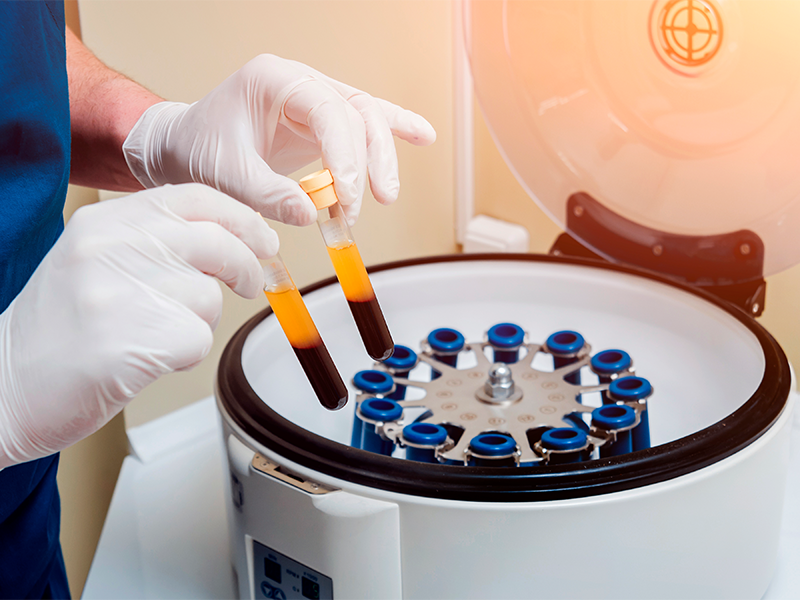Peripheral defocus lenses: an option to slow the progression of myopia
14/10/2025

05/12/2019
The innovative application of fibrin membrane to oculoplastic surgery
Dr. Marta López Fortuny, consultant oculoplastic surgeon at the Barraquer Centre of Ophthalmology, explains the innovative application in oculoplastic surgery with fibrin membrane, a type of platelet-rich plasma that provides unprecedented benefits in patient recovery.
Firstly, what is fibrin membrane?
It is a platelet-rich plasma preparation also known as PRP, which provides extra value to recovery from any kind of oculoplastic surgery. It concerns operations on the eyelids, the tear duct and the eye socket for different pathologies, reconstruction or purely aesthetic procedures like blepharoplasty.
How is the membrane produced?
We produce it in the Centre’s lab using the patient’s own blood. Doing this means we can ensure that all the protocols are followed and that the membrane is produced under optimum conditions so that it is viable, the platelets do not break and release the growth factors. An hour and a half before operating, we already have the fibrin membrane prepared so that it is in the best possible condition at the time of surgery.
You mean it’s applied during surgery?
Yes, it’s an intraoperative procedure. When we are halfway through the surgery, we get the membrane and apply it before closing up, so that it stays inside, and also after, on top of the stitches. Once the operation is finished, the platelet growth factors will be released throughout the area to provide extra benefits that the blood alone would take much longer to produce. When all the components have been released, after four or five days, the membrane dissolves.
What are the benefits of this procedure?
Firstly, we manage to reduce the post-operative period which until now was unprecedented in our specialism: quicker healing and less bruising, oedema and swelling. But, in addition to that, this preparation has multiple benefits for the patient. It’s an autologous and biocompatible procedure the patient won’t reject as it is made with their own blood, meaning that anyone of any age can be given it, even if they are on medical treatment. In addition to being free of contraindications, it is a completely painless procedure, because the only thing we need from the patient is their blood, which we draw in the preoperative blood test anyway. Lastly, we must say that the application of the fibrin membrane does not extend the duration of the surgery.
What are the differences between the postoperative period of a patient who has had this membrane applied and one who has not?
It depends on each patient but, generally speaking, in normal patients healing is complete after three months, however, patients who have had the membrane applied, already look a lot better after a month and a half. In addition, after ten days they have less bruising and swelling. We have compiled this evidence in a study that we conducted in the Centre with one hundred eyes and we have put them in objective terms using photos.
“We managed to reduce the post-operative period which until now was unprecedented in our specialism: quicker healing and less bruising, oedema and swelling.”
When did you start to work with fibrin membrane and which procedures is it applied to?
It’s been a year since we first started this procedure and we began to work with fibrin membrane, which until now hadn’t been used in oculoplastic surgery. We can apply it to any operation in our area of specialism: to blepharitis, where we remove droopy eyelids and bags from the eyes; in reconstructions to patients who have lost an eye and are getting an implant; to tear duct procedures where we need healing to be very quick to avoid infections...
How has it been received by the patients?
Very well! It has been readily accepted because it has huge benefits, plus there are no contraindications or incompatibility issues. It does not come from an external source like silicone or hyaluronic acid; it’s endogenous, from the patients themselves.
Even though the application to oculoplastics is innovative, we’ve been hearing about platelet-rich plasma preparations for quite some time now. How did you decide to start working with this procedure?
We’re always looking for new formulas to make tissue regenerate more quickly and so that the postoperative period is more straightforward for the patient. There has been a PRP culture and this type of preparations have been used in multiple settings for some years now—from trauma units to facial treatments—because it has been proven that blood has all the necessary components required to regenerate tissue and that its effects are multiplied when concentrated. We have sought a different type of application because in our specialism this innovation provides great added value to those patients who have active jobs and social lives and want to get back to these activities as soon as possible. We’re not talking about a recently operated arm or a leg that can be covered up. As these are surgeries on highly visible areas like the eyelids and the eye socket, a quick recovery with fibrin membrane is a huge step forward in oculoplastic surgery.